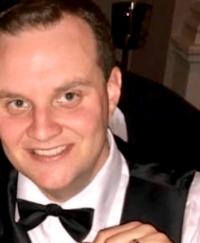In August of 2015, Craig Livoti and his fiancée were almost finished with their wedding preparations. They were sitting together on their hardwood floor, putting together goody bags, two weeks before the ceremony. Something about the awkward positioning “tweaked” Craig’s back, and it hurt a lot over the next day or two. So Craig went to the doctor and had an MRI.
Craig will never forget meeting with the doctor to go over that scan. “Okay, well, you have a slightly herniated disc right here,” said the doctor. That explained Craig’s back pain. But it wasn’t all the MRI revealed. “Unfortunately, you also have this: a very, very, very large tumor on this nerve.”
Craig had an extremely rare tumor called a dumbbell tumor (named for its shape—narrow in the middle, larger on either side). It had been growing for years, causing symptoms so gradually they hardly seemed noticeable: some night pain in his back, some itching and numbness in his right leg, occasional brief shooting leg pain. There was no way to see or feel from the outside that there was a tumor on the nerve leading to that leg. Craig just figured that since he was now in his 30s, old sports injuries were catching up with him.
Like all dumbbell tumors, Craig’s got its shape by growing along a nerve close to the spinal cord. “It just kind of grew like a balloon,” Craig says. “So wherever there was free space is where it went.” One part of the tumor grew close to the delicate spinal cord. A thin part of the tumor—the grip of the dumbbell—grew into the narrow opening through which the nerve exits the bony spinal column. And another part grew outside the bony walls of the spinal column.
In Craig’s case, the section outside the spinal column was very large. “I heard it compared to the size of a large pear or a softball,” he says.
That large size was actually something of a blessing. From the beginning, the doctors agreed that the tumor was probably benign. It had been growing for so long that “if it had been cancerous,” Craig says, “it probably would have killed me already.” Throughout the experience, he never really worried about cancer.
But he had plenty of other things to worry about.
Craig’s mind churned. Just about to get married and happily picturing his future, he was faced with the unknowable. Would his right leg be permanently injured? Would he have lifelong back pain? Would he be paralyzed? Would his future ever be what he had imagined?
In the days after the tumor was discovered, Craig and his fiancée met with doctor after doctor. They all agreed the tumor should be removed. But the tumor type is so rare that most of the spinal surgeons had seen only one case, or none at all. And the surgery would be complex: It would bring the surgeon close to the delicate spinal cord. It would require removing sections of bone from the spinal column and then re-stabilizing the spine. It would also involve surgery to remove a nerve tumor without damaging the nerve. It all seemed like a tall order.
But Craig and his fiancée heard about someone they should see: Dr. Paul McCormick, Director of The Spine Hospital at the Neurological Institute of New York. Dr. McCormick is experienced with dumbbell tumors. He even teaches other surgeons how to remove them.
Two days before their wedding, Craig and his fiancée met with Dr. McCormick. His confidence was contagious, says Craig. “I’ll never forget it. He was the first person in a couple weeks to make me feel that everything was going to be okay. It was still very scary, but he took away part of that fear.”
Dr. McCormick described how he would go about removing the tumor, how he would trace it back to see where it ended and the surgical precautions he would take to help ensure Craig would have no loss of function, including the use of his legs. “And he kept emphasizing, ‘You’re not sick, you’re not dying, you’re injured. And we’re going to get you better.’ ”
Craig left Dr. McCormick’s office that Thursday feeling so much better. “We just started crying,” says Craig. “It was the first non-scary meeting we had had. He made us feel so much better… and he was the first person in a couple weeks to make me feel that everything was going to be okay.”
He and his fiancée held their rehearsal dinner as planned on Friday, got married on Saturday and were on their honeymoon by Monday.
When they returned home, they moved into the house they had bought in New Jersey. Then Craig went in for surgery.
The day of surgery, he was anxious. But he trusted that Dr. McCormick was the right surgeon for his situation. “It was a 7- or 8-hour surgery,” he says. It involved nerves, bones and muscles. The incision extended from Craig’s shoulder blades down to his hips.
The extensive surgery was a resounding success: The entire tumor was removed, with no damage caused to Craig’s spinal cord or the nerve under the tumor.
The day after surgery, Craig walked a short distance with a walker. A few days later he graduated to walking slowly with a cane. “I got out of the hospital about a week after surgery, and I really started feeling better once I got home,” he says.
Today Craig is doing great. He is fully healed and back to working.
And he’s back down on the hardwood floor too… this time to play with his 1-year-old son.
“Dr. McCormick gave comfort when it was needed most and when everything seemed dark.” says Craig. “I can’t express it enough. I owe him everything.”
Learn more about Dr. McCormick at his bio page here.



